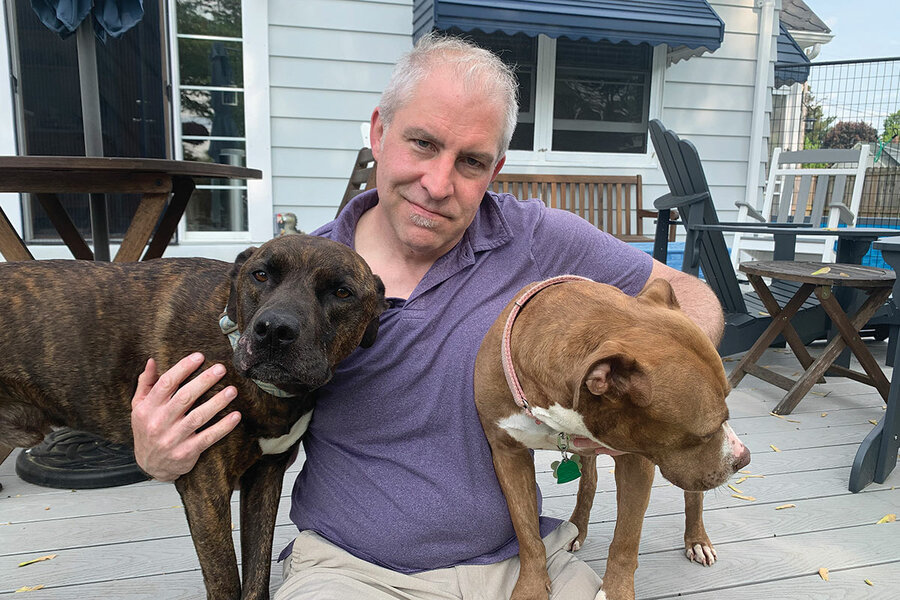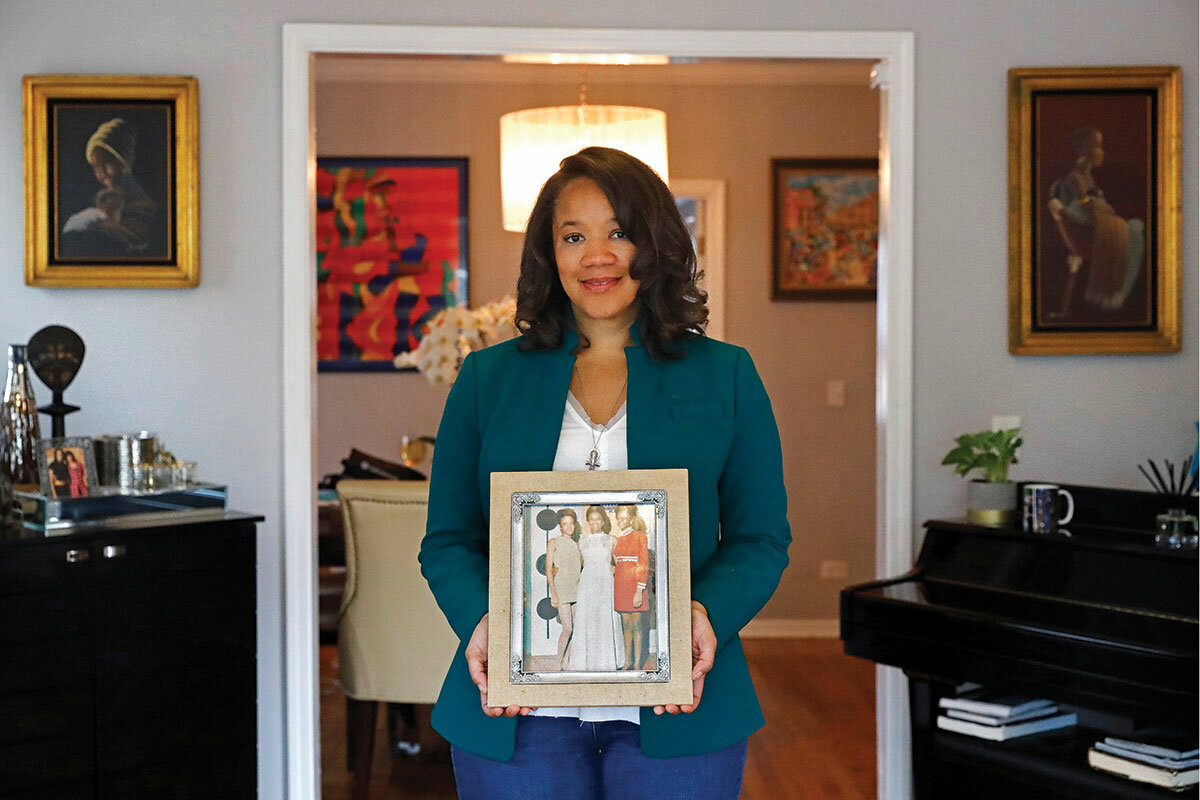What does it mean to craft a ‘lifestyle of repair’?
Loading...
| Lansing, Mich.
Ross Yednock swam in a sea of American middle-class well-being all his life. He grew up in 1980s Midwestern suburbs, enjoyed high school football stardom, and graduated from Michigan State University without debt. He’s had a career in Michigan Democratic politics and state government while exercising his business chops on the side in profitable real estate investments.
But as the modern American racial reckoning heated up, the temperature of that sea of privilege grew uncomfortable for Mr. Yednock. He fell into intense self-interrogation about that life, and how much of it he owes to being white.
Speaking about it with furrowed brow, carefully editing his words, he tries to capture the essence of the civic responsibility he feels to repair what he calls a history of “brutality” to Black people that continues to this day.
Why We Wrote This
A story focused onFor white allies in the reparative justice movement, participation often reflects an evolving view of their civic responsibility.
With the recent crescendo of the reparative justice movement into the mainstream, Mr. Yednock’s is an examination playing out in pockets of white America. It’s seen in California’s consideration of financial payments to the descendants of Black residents discriminated against in the 19th century; in the housing reparations program passed by Evanston, Illinois; in corporate and higher education efforts; and in countless faith-based programs shifting church assets to the Black community.
“It’s been a slow build, and it’s really kind of rapidly increased in the last five to 10 years,” Mr. Yednock says of his own stir over historical racial injustices from slavery to lynchings, mass incarceration, police brutality, and segregation.
It culminated in his decision last fall to give voluntary reparations to the Black community.
Divorced and without dependents, save two ebullient pit bull rescues, he rewrote his will to give all his assets – cash, home, investments, life insurance – to the Justice League of Greater Lansing Michigan. Plus, he gives 1% of his monthly income to that faith-based reparations organization, which has made more than 35 presentations here promoting reparations in the past year and a half.
This is what is called “practicing a lifestyle of repair,” says Robin Rue Simmons, the former Evanston alderwoman who led the push for the nation’s first municipal reparations program there. The movement must have white allies to succeed, she and other activists say. And that ally group is growing, she adds.
Evolving views
Nonetheless, the topic is explosive.
Baptist minister Michael Woolf, of Lake Street Church of Evanston, rakes his hair anxiously, recalling a few “very nice church ladies” spewing invective at him when his congregation decided last year to offer joint ownership of its building to a Black congregation that felt pushed to break away from the church decades ago.
The Rev. Jason Poling, who oversaw reparations discussions at St. Andrew’s Episcopal Church in Pasadena, Maryland, acknowledges, “There are very good reasons why ... absolutely good-hearted people ... can believe it is not a good idea.”
Mr. Yednock, for example, says that his initial reservations about reparations included such questions as economic feasibility, accountability for funds – and even the validity of the notion that Black Americans monolithically support reparations.
Indeed, only 30% of Americans polled by the Pew Research Center in 2021 supported repayment of some sort to descendants of enslaved people – with 80% of white Americans and majorities of Hispanic and Asian Americans against the idea. And Pew reported a statistically significant decline in the percentage of white adults who believe that the legacy of slavery affects the position of Black people in America today “a great deal” or “a fair amount” – from 58% in 2019 to 50% in 2021.
And yet, there is a growing body of reparations plans that could only be happening with white support – and the stories of shifting thought behind it.
A national survey by historian Cane West for the Episcopal Diocese of Washington, D.C., found 48 reparations efforts formed since 2015 in such institutions as churches, corporations, and universities, most of which aimed to provide some type of financial compensation.
The African-American Redress Network documents 463 instances of reparations and redress, 85% of which are not financial repair, but historical analysis, commemoration, or memorialization.
An “aha moment” and self-reflection
Mr. Yednock’s path to voluntary reparation was equal parts history study he didn’t get in school and a searing exploration of what he considers his own unconscious complicity in modern racism.
One powerful example of making historical connections, he notes, is the fact many white people cite as their “aha moment”: that only a small fraction of Black World War II veterans were able to receive the GI Bill education and housing financing that was the foundation of the modern white middle class.
Mr. Yednock gets choked up recounting some experiences in his personal racial reckoning. Like the head-spinning question a Black acquaintance once posed, “When did you realize you were white?” Or his ill-chosen college karaoke performance of Elvis Presley’s “In the Ghetto” in front of a mostly Black audience that included his biracial girlfriend; or uneasily standing by as his fellow high school football players racially razzed a Black teammate.
Reparations are “a cycle, not a journey with an end point,” writes the Rev. Peter Jarrett-Schell, author of “Reparations: A Plan for Churches.” He chaired the Reparations Task Force of the Episcopal Diocese of Washington, which produced a resolution of apology, repentance, and commitment to reparation this year.
Advocates have various approaches, but all start with education that answers what Mr. Jarrett-Schell calls “the moves people make”: such assertions as “slavery was not that bad, ... it’s the past and doesn’t pertain to us, ... we didn’t participate, ... it’s undoable ... with too many sticky questions involved [such as] to whom is it owed?”
Perhaps nowhere is the gut-wrenching recognition of harms done more transformational for individual white people than in church communities, where it’s not uncommon to uncover forgotten racist histories. One Baltimore-area white Episcopal church had to face the fact that in 1932, it took the proceeds from the eminent domain takeover of its sister Black church nearby and used the funds to pay off its own debt. That left the penniless Black church congregation to scatter with no invitation to join the other.
The humbling recognition of such harms, says Mr. Jarrett-Schell, suggests repayment is “necessary but insufficient.”
The Rev. Grey Maggiano, rector of Memorial Episcopal Church in Baltimore, says he watched individual “changes of heart” in his congregation as it moved last year to devote $50,000, or 10% of its endowment, to reparations. That was a response to the acknowledgment that one of Memorial’s founding directors funded the church while enjoying the profits of work by 400 people he enslaved, including ancestors of a current deacon.
“I know it’s tough to acknowledge some of this history,” explains Dr. Woolf, in Evanston, “but we can get past the initial sort of anger at being challenged by it; then we have an immense opportunity for white members to have a redemption arc, to be able to talk frankly about race in a way that can be useful.”
Finding the right fit
One of the biggest hurdles in his own reparation conversion, says Mr. Yednock, is “how you get over the narrative that reparations will negatively impact white people.” Further, the no-strings-attached philosophy that most reparations programs embrace was counter to his basic business intuition.
“You want to be sure there’s accountability,” he says, “[but] is that a natural thing or is that controlling, white-supremacist patronizing, [even if] the intent is not racist? I had to get over the desire for directing the payments.”
Ultimately, the Justice League of Greater Lansing’s reparations structure was a comfortable fit for him, with its endowment fund managed by an all-Black advisory council that will direct money to support education scholarships, homeownership programs, and business startups.
“I have close friends who don’t agree with me on this. They get why I’m doing it, but they say, ‘You’re a white guy with no connection to the Black community.’”
Building a genuine connection between Black and white communities, he and many reparations supporters say, is the insurance against the pay-to-make-this-go-away gesture.
Mr. Yednock hopes Americans, at heart, are better than that.
This story was produced as part of a special Monitor series exploring the reparations debate, in the United States and around the world. Explore more.







